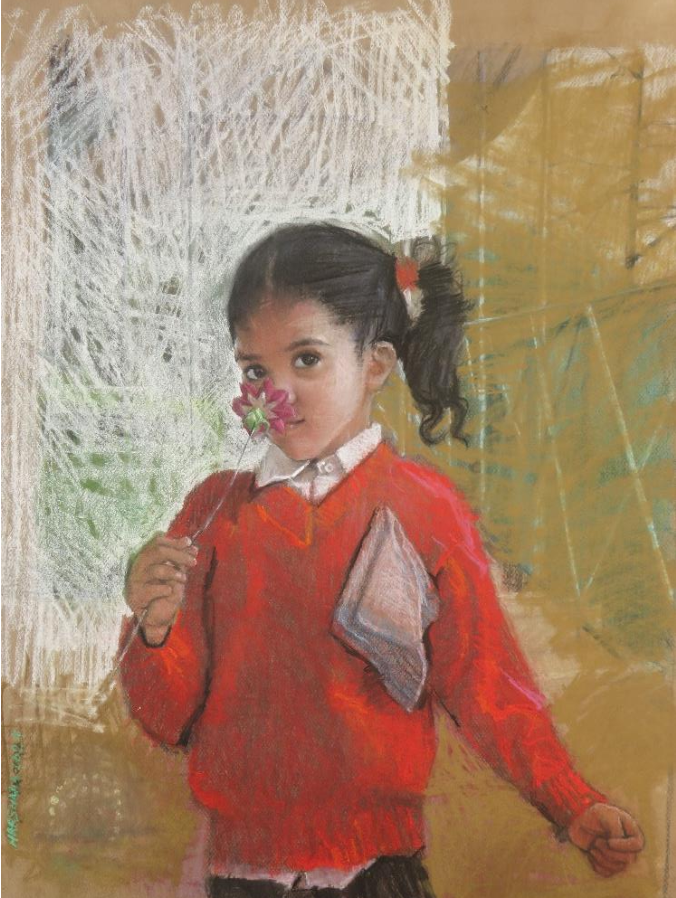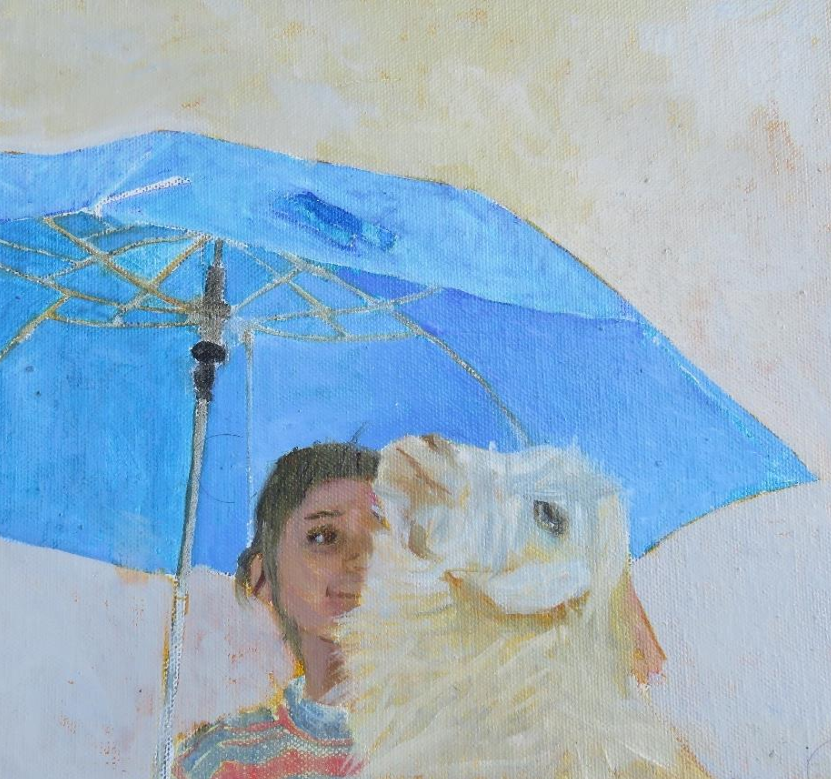Queens of the Hills
Photo: Karan Madhok
In a new collection, Goan artist Harshada Kerkar paints intimate portraits to celebrate the lives of locals and villagers around Mussoorie.
While she was in Mussoorie one morning, the Goan artist Harshada Kerkar saw a young girl on her way to school. The girl was crying, as she was unable to reach up to a height and grab a dahlia flower that sat perched by the roadside. Kerkar climbed on a rock, plucked the flower, and handed it to the child.
“The little child was so overcome,” wrote Kerkar, “she just looked at me as if she was a Queen who had just been granted her wish.” Wearing a red sweater of her school uniform, with her hair tied with a matching red bow, the child took a sniff of the dahlia. Kerkar said that the pose reminded her of Indian queens as depicted in ancient miniature art. The moment inspired the portrait, Queen, and a collection to celebrate of the royalty of everyday people around the hillside.
Queen
One of the most-popular hill stations in the country, Mussoorie—sitting on the Himalayan foothills of Uttarakhand—is often known as the ‘Queen of the Hills’. The town is a crown above the Doon Valley encircled by gorgeous mountainous views, a busy touristy Mall Road, and lush flora and fauna in surrounding villages and forests. Kerkar’s work, however, re-defines the Queendom of Mussoorie, handing the crown and shifting the gaze away from the towns’ larger landscape to the local populace that make the place their home.
Kerkar’s liaison with Mussoorie began about a half-dozen years ago when she was invited by the Lal Bahadur Shastri National Academy of Administration (LBSNAA), a civil service training institute, to work on “larger than life” sketches of sanitation workers and rag pickers of Mussoorie, which served as murals across the walls around the institute. In the extended time she spent here—which included the panic and uncertainty of the pandemic—Kerkar said that she was able to form close relationships with many local villagers. Her latest collection, “Queens of Mussoorie”, was a result of these relationships, featuring a series of portraits of women and children from the region.
“Queens of Mussoorie” is being exhibited at the VR Art Space Landour, based in Landour (Mussoorie), from April 10 to May 29. The exhibition features 24 portraits by Kerkar created over the past few years.
The most memorable of these artistic ‘snapshots’ are the many portraits of mothers and daughters from the local villages: Mothers carrying their infants and toddlers on their way to work, daughters delighted to be in their mothers’ embrace.
Kerkar was born in the Ker village in Goa’s Pernem taluka. Her father was Chandrakant, an accomplished Goa-based artist and teacher. Kerkar completed her Bachelor’s from the SNDT University in Mumbai, and has since participated in several group and solo shows, including at the National Lalit Kala Akademi Exhibition in New Delhi and the 2028 Serendipity Festival of Arts. Much of her artwork reacts to nature and the people closest to living a synchronous life with the natural world: whether in the beach-state of Goa, or in the Himalayan hillside.
Kerkar, however, says that her time in Mussoorie was able to inspire her in a strikingly different manner to her home-state. “This is entirely new to me,” she says. “Since childhood, I was just busy painting Goan sceneries—so, all my inspiration was coming from Goa, except for a few times whenever I attended art camps in other states. I used to earlier think that it is Goans who are very hospitable—and they used to be in 70s. They were naturally very welcoming to any outsiders. But those things have slowly become very commercial. Now it has all changed. But when I come to Mussoorie and visit any place here, I feel that warmth, that welcoming nature.
“I spent some time in the market area, and all of the kids wanted to be sketched. That’s why I get to do lots of experiments here, which is otherwise not possible! In a place like Goa, that cannot happen.”
Kerkar’s time working at the LBSNAA also coincided with the pandemic. The “chaos” of this time, says Kerkar, helped her grew strong bonds with a number of families from the Dalai Hill area near the academy. She explains how she met a young girl who stood outside, waiting for the call of a bird called the kafal pako—the ‘Indian cuckoo’. “I feel that, when I was making a portrait of this girl, there was a lot more to this story. The beauty of the whole valley seems to be in that portrait.”
Kerkar’s current exhibition uses the mediums of charcoals, oils, and dry pastels, the latter of which features in some of the most striking portraits of the collection. “I had been working in this medium [dry pastels] since I started learning portraiture,” says Kerkar. “It comes very easy for me.”
Shepherd Girl who Blue Umbrella
Kerkar plans to be in Mussoorie for almost two more months during the course of the exhibition, while she continues working on more portraits. Much of her newer work is inspired by The Blue Umbrella, a novel by famous Landour-based author, Ruskin Bond. But Kerkar’s gaze remains on the young and the women of the region, and Kerkar’s rendition of this ‘story’ features a young shepherd girl with her sheep under that famous blue umbrella.
“Now I’m planning some bigger ones,” she says, of the next in the ‘Blue Umbrella’ series. “I will add a ship to it: I’m trying to create yet another story.”
Kerkar’s sketches and paintings present a sense of inherent joy and innocence. In each portrait, she shares a giddy snapshot of intimate lives, which include children in conversation with sheep or cats, cows and monkeys at rest, men making tea, local shoemakers, a female ragpicker carrying a burden that seems to rise twice as high above her head. The most memorable of these artistic ‘snapshots’ are the many portraits of mothers and daughters from the local villages: Mothers carrying their infants and toddlers on their way to work, daughters delighted to be in their mothers’ embrace.
These are women making time in their daily journeys for little moments of joy, to smile, to smell the dahlias, to play with their toys, to gaze beyond the horizon. To simply be who they are: the queens of these hills.
***
Karan Madhok is a writer, journalist, and editor of The Chakkar, whose fiction, translation, and poetry have appeared in Gargoyle, The Literary Review, The Bombay Review, The Lantern Review, F(r)iction, and more. He is the founder of the Indian basketball blog Hoopistani and has contributed to NBA India, SLAM Magazine, FirstPost, and more. His debut novel is forthcoming on the Aleph Book Company. You can find him on Twitter: @karanmadhok1 and Instagram: @karanmadhok.



